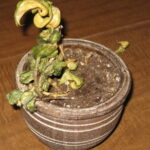This popular houseplant derives its name from the fact that the leaves fold together at night like hands in prayer. The prayer plant is coveted for its interesting foliage. It is a native of the tropical rain forests of Brazil, which might lead you to believe that the prayer plant is difficult to grow as a houseplant. This is, however, a very easy-care, easy-to-grow houseplant.
There are several varieties of the genus Maranta to which the prayer plant belongs. The one most commonly grown as a houseplant, though, is M. leuconeura. Another form of this variety – M. leuconeura kerchoviana – is also frequently found in homes. Both of these forms of the prayer plant grow to be about 12 inches tall and have a spreading habit. The difference between the two is in the markings on the leaves. The M. leuconeura has paler green margins and midribs with dark brown markings and deep purple or maroon undersides. The leaves are also slightly smaller than the M. leuconeura kerchoviana. The latter variety has light-green, glossy leaves with dark brown markings along the midribs. The underneath part of the leaves is a dull, pale, bluish-green.
The prayer plant does not like bright light, which can cause the leaves to fade and even burn. It also likes its soil kept evenly moist but not soggy. During the spring and summer when the prayer plant experiences its growing spurt, it will probably require more water. Also, prayer plants produce rather insignificant white flowers during their growing period. I usually clip these off as soon as they appear in order to keep the plant looking bushy and full. During the winter months when its growth slows, you can actually let the top part of the soil dry out some between waterings. However, the heat and consequent lack of humidity in the home during the winter will require that you provide the plant with some additional humidity. Do this by misting regularly and perhaps adding a humidity tray or by using a humidifier in the room.
Use a rich potting mix for your prayer plant. Fertilize about every two weeks using a good water-soluble fertilizer during the spring and summer months.
I propagate prayer plants by just placing a cutting in water and allowing it to take root. You can also take about a 4-inch cutting with at least three leaves on it and place in a moist potting mix of half peat moss and half sand. Cover with a clear plastic bag and keep in a dark area until it roots. This takes much longer, however – about 4-6 weeks. I cannot figure out, personally, why anyone would bother with this method of propagation.
The prayer plant is a great plant to add to any interior landscaping. You can also put it outside in the summer, but you need to make sure that you keep it out of direct sun. You will also find that this is a rather forgiving plant and one that you can easily grow in your home.
References:
DeWolf, Jr., Gordon P., ed. Taylor’s Guide to Houseplants. Boston, MA: Houghton Mifflin Company, 1987, p. 380.
Huxley, Anthony, ed. Success with House Plants. Pleasantville, NY: The Reader’s Digest Association, Inc., 1979, p. 264.
For information on some other easy-to-grow plants with colorful foliage, see:
Coleus
2 Easy-to-Grow Purple Foliage Plants








